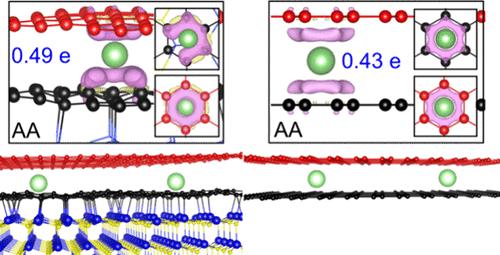SiC Substrate-Enabled Modulation of Li+ Ion Intercalation Thermostability in Strained Bilayer Graphene
IF 3.2
3区 化学
Q2 CHEMISTRY, PHYSICAL
引用次数: 0
Abstract
Two-dimensional (2D) van der Waals (vdW) materials have emerged as vital components in various technological fields. Ion intercalation into vdW materials is a versatile technique for material exfoliation, property induction, and stacking-order manipulation. However, the role of the substrate and its consequential impact on ion intercalation thermodynamics in vdW materials are yet to be well understood. In this work, employing density functional theory (DFT) calculations, we investigate the interplay between the SiC substrate and Li+ ion intercalation in the strained bilayer graphene grown on the SiC (0001) substrate. Our analysis covers five stacking orders (AA, AB, BA, SP, and IM stackings), revealing that the SiC substrate enhances the thermostability of Li+ ion intercalation. This enhancement is attributed to the special sp3-hybrid carbon atoms in the bottom graphene layer. We observed that the SiC substrate promotes selective intercalation with a stacking preference, favoring AA stacking over the other four stackings. Surprisingly, the SiC substrate not only disrupts the crystal symmetry within bilayer graphene, leading to distinctive intercalation behaviors in AB and BA stackings ─absent in free-standing bilayer graphene─but also modulates the Fermi level shift downward by inducing p-type doping to facilitate Li+ ion intercalation. Our study offers a comprehensive understanding of the intricate relationship between substrates and ion intercalation in layered materials, thereby paving the way for tailored applications of layered vdW materials with substrates through ion intercalation.

利用碳化硅基底调制应变双层石墨烯中的锂离子插层热稳定性
二维范德华(vdW)材料已成为各个技术领域的重要组成部分。离子插层到 vdW 材料中是一种多功能技术,可用于材料剥离、属性诱导和堆叠阶操作。然而,基底的作用及其对 vdW 材料中离子插层热力学的影响仍有待深入了解。在这项工作中,我们利用密度泛函理论(DFT)计算,研究了在碳化硅(0001)基底上生长的应变双层石墨烯中,碳化硅基底与 Li+ 离子插层之间的相互作用。我们的分析涵盖了五种堆积阶(AA、AB、BA、SP 和 IM 堆积),结果表明,SiC 衬底增强了 Li+ 离子插层的耐热性。这种增强归因于底部石墨烯层中特殊的 sp3 杂化碳原子。我们观察到,SiC 衬底促进了具有堆叠偏好的选择性插层,AA 堆叠比其他四种堆叠更受青睐。令人惊讶的是,SiC 衬底不仅破坏了双层石墨烯内部的晶体对称性,导致 AB 和 BA 堆叠出现独特的插层行为--这在独立双层石墨烯中是不存在的--而且还通过诱导 p 型掺杂来调节费米级下移,从而促进 Li+ 离子的插层。我们的研究全面揭示了层状材料中基底与离子插层之间错综复杂的关系,从而为层状 vdW 材料通过离子插层与基底的定制应用铺平了道路。
本文章由计算机程序翻译,如有差异,请以英文原文为准。
求助全文
约1分钟内获得全文
求助全文
来源期刊

The Journal of Physical Chemistry C
化学-材料科学:综合
CiteScore
6.50
自引率
8.10%
发文量
2047
审稿时长
1.8 months
期刊介绍:
The Journal of Physical Chemistry A/B/C is devoted to reporting new and original experimental and theoretical basic research of interest to physical chemists, biophysical chemists, and chemical physicists.
 求助内容:
求助内容: 应助结果提醒方式:
应助结果提醒方式:


